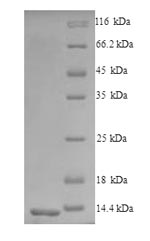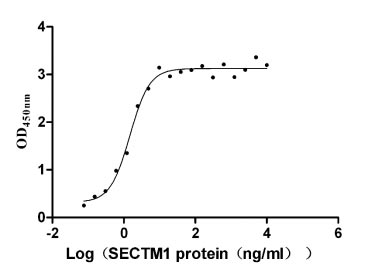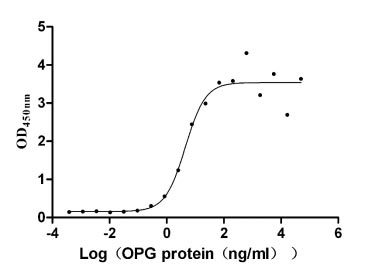Recombinant Mouse C-C chemokine receptor type 5 (Ccr5), partial
In Stock-
货号:CSB-YP004844MO
-
规格:¥1836
-
图片:
-
(Tris-Glycine gel) Discontinuous SDS-PAGE (reduced) with 5% enrichment gel and 15% separation gel.
-
Based on the SEQUEST from database of Yeast host and target protein, the LC-MS/MS Analysis result of CSB-YP004844MO could indicate that this peptide derived from Yeast-expressed Mus musculus (Mouse) Ccr5.
-
Based on the SEQUEST from database of Yeast host and target protein, the LC-MS/MS Analysis result of CSB-YP004844MO could indicate that this peptide derived from Yeast-expressed Mus musculus (Mouse) Ccr5.
-
-
其他:
产品详情
-
纯度:Greater than 90% as determined by SDS-PAGE.
-
基因名:
-
Uniprot No.:
-
别名:Ccr5; Cmkbr5C-C chemokine receptor type 5; C-C CKR-5; CC-CKR-5; CCR-5; MIP-1 alpha receptor; CD antigen CD195
-
种属:Mus musculus (Mouse)
-
蛋白长度:Partial
-
来源:Yeast
-
分子量:12.6kDa
-
蛋白标签:N-terminal His-tagged/Tag-Free
-
产品提供形式:Liquid or Lyophilized powder
Note: We will preferentially ship the format that we have in stock, however, if you have any special requirement for the format, please remark your requirement when placing the order, we will prepare according to your demand. -
缓冲液:Tris-based buffer,50% glycerol
-
储存条件:Store at -20°C/-80°C upon receipt, aliquoting is necessary for mutiple use. Avoid repeated freeze-thaw cycles.
-
保质期:The shelf life is related to many factors, storage state, buffer ingredients, storage temperature and the stability of the protein itself.
Generally, the shelf life of liquid form is 6 months at -20°C/-80°C. The shelf life of lyophilized form is 12 months at -20°C/-80°C. -
货期:3-7 business days
-
注意事项:Repeated freezing and thawing is not recommended. Store working aliquots at 4°C for up to one week.
-
Datasheet & COA:Please contact us to get it.
相关产品
靶点详情
-
功能:Receptor for a number of inflammatory CC-chemokines including CCL3/MIP-1-alpha, CCL4/MIP-1-beta and RANTES and subsequently transduces a signal by increasing the intracellular calcium ion level. May play a role in the control of granulocytic lineage proliferation or differentiation. Participates in T-lymphocyte migration to the infection site by acting as a chemotactic receptor.
-
基因功能参考文献:
- Data provides evidence that CCR5 has an essential role in bone-destructive conditions through the functional regulation of osteoclasts. PMID: 29263385
- Blockade of CCR5-mediated myeloid derived suppressor cell accumulation enhances anti-PD1 efficacy in gastric cancer PMID: 29303012
- the interaction between CCR5 and its ligands promotes the proliferation of CCR5(+) polymorphonuclear-myeloid-derived suppressor cells at the bone marrow PMID: 29166611
- This study suggested a potential neuroprotection in the absence of CCR5 receptor during global brain ischemia and reperfusion injury. PMID: 28294064
- Studied the effects of CCL5-CCR5 interactions in breast cancer metabolism, and findings suggest that CCL5-CCR5 interactions in the tumor microenvironment modulate metabolic events during tumor onset to promote tumorigenesis. PMID: 29216863
- Loss of CCR5 is associated with astrogliosis, amyloid-beta deposit and impaired memory function. PMID: 26910914
- These findings suggest that CCR5 is likely participating in demyelination in the spinal cord in experimental autoimmune encephalomyelitis PMID: 26985768
- These results demonstrate that CCR5 plays an important role in neuroplasticity, learning and memory, and indicate that CCR5 has a role in the cognitive deficits caused by HIV. PMID: 27996938
- The Ccr5 is crucial in directing T cells toward the Langat virus -infected brain, as well as in suppressing neutrophil-mediated inflammation within the Central Nervous System. PMID: 27183602
- This study showed that CCR5 ablation exacerbated Japanese encephalitis without altering viral burden in the extraneural and CNS tissues, as manifested by increased CNS infiltration of Ly-6C(hi) monocytes and Ly-6G(hi) granulocytes. PMID: 27439902
- this review discusses the role of CCR5 in recruitment and activation of myeloid-derived suppressor cells in melanoma PMID: 28382399
- These results suggested that CCR5 signaling is involved in embryo loss in Toxoplasma gondii infection during early pregnancy and that apoptosis is associated with embryo loss rather than direct damage to the fetoplacental tissues. PMID: 28630065
- The upregulation of CCR5 on the surface of the CD8(+) T cells increases the number of contacts with Ag-bearing dendritic cells, which ultimately results in increased CD8(+) T cell response to Ag rechallenge. PMID: 26994221
- CCL4-CCR5 axis can contribute to breast cancer metastasis to bone by mediating the interaction between cancer cells and fibroblasts in bone cavity. PMID: 27177471
- Cytokine-induced killer cells interact with tumor lysate-pulsed dendritic cells via CCR5 signaling. PMID: 27216980
- this study shows that diosgenin-mediated anti-allergic effects are associated with increased number of Foxp3+ Treg cells expressing CCR5 PMID: 27886644
- CCR5 deficiency increased the production of TNF-alpha following LPS treatment through increased activation of the p38 pathway in the kidney, resulting in renal apoptosis and leukocyte infiltration and led to exacerbation of LPS-induced acute kidney injury. PMID: 26055553
- In West Nile virus infection of the central nervous system, CCR5 activity is required to limit viral burden in the cerebral cortex. PMID: 26667390
- Data show that the activation of mammalian target of rapamycin complex mTORC1 during encephalomyocarditis virus infection is chemokine (C-C) receptor 5-dependent and promotes the translation of inducible NO synthase (iNOS) and cyclooxygenase (COX)-2. PMID: 26408666
- CCL5-induced endothelial progenitor cell migration was increased by overexpression of CCR5 and that increase was abolished by addition of CCL5 antibody, suggesting CCL5/CCR5 interaction is involved in chemotactic effects of endothelial progenitor cells. PMID: 25889019
- These findings show that migration and activation of immune cells via CCR5 is required for controlling N. caninum parasites during the early phase of the infection. PMID: 25558986
- our results suggest that the detrimental effects of C5a in this model are partly mediated through CCR5 activation downstream of C5aR1, which may be evaluated for potential therapeutic exploitation in ALI/ARDS. PMID: 25999468
- CCR5 blockade promotes M2 macrophage activation and improves locomotor activity after spinal cord injury in mice. PMID: 25212047
- CCR5 KO mice show less cartilage degeneration but no change in bone or synovial response to medial meniscal destabilization. PMID: 25498590
- Results indicate that CCR5 deficiency modifies the nigrostriatal dopaminergic neuronal system and bidirectional interaction between neurons and glial cells via CCR5 might be important for dopaminergic neuronal survival PMID: 22922220
- These data bring new insights on the association between viral infections and the chemokine receptor CCR5. PMID: 25939314
- CCR5 is essential to the control of T. gondii infection and to maintain the metabolic, hepatic and intestinal integrity. PMID: 25119429
- Mycobacterium infection significantly increased CCR5 expression in macrophages there by facilitating the activation of its downstream signaling. These events culminated in up-regulation of the immunosuppressive cytokine IL-10 production PMID: 24695099
- These results reveal novel alloreactive CD8 T cell specificities in CCR5-deficient recipients of single class II MHC renal allografts that mediate rejection of the allografts. PMID: 25172484
- This study provides evidence for an indirect pathologic role of CCR5 and a novel protective effect of LCN2 in combination with inhibition of CCR5 in HIV-associated brain injury. PMID: 25031461
- mediates neutrophil recruitment in acute lung injury PMID: 23860188
- CCL3-CCR5-mediated fibroblast accumulation may be required, in addition to leukocyte infiltration, to induce full-blown colitis-associated carcinogenesis. PMID: 24510316
- this study for the first time demonstrates the importance of TLR2/CCR5 crosstalk as a significant determinant of Leishmania donovani entry in host macrophages. PMID: 24617012
- Inflammation-induced hepatocellular carcinoma is dependent on CCR5 in mice. PMID: 23526353
- absence of CCR5 delays the resolution of inflammatory responses triggered by single-walled carbon nanotubes PMID: 22438032
- The CCR5/MIP-1alpha axis may contribute to migration of infected cells to the brain and consequently affect the pathogenesis during Rocio virus infection. PMID: 24080631
- These findings suggest that whereas CCR5 plays a minor role in regulating immune cell infiltration and inflammation in metabolic tissues, deficiency of CCR5 impairs systemic glucose tolerance as well as adipose tissue and muscle insulin signaling. PMID: 23941876
- Pain responses of CCR5 knockout mice to chemical or inflammation stimuli are milder than those of CCR5 wild-type mice. PMID: 23147416
- These results suggest that the absence of CCR5 may boost the immune response with a high neutrophil recruitment which most likely helps in viral clearance. PMID: 23391218
- ata indicate an expansion of CXCR3(+) and CCR5(+) T cells was observed in the tumor. PMID: 23326300
- the critical mechanism underlying enhanced effect of CCR5-transducedneural stem cells on experimental autoimmune encephalomyelitis is the early migration of chemokine receptor-transduced NSCs into the inflamed foci. PMID: 22526024
- CCR5 deficiency suppressed lung tumor development through the inhibition of nuclear factor-kappaB/STAT3 pathways and the downregulation of MCP-1 in the carcinogen-induced lung tumor model. PMID: 22907530
- the immune responses against JEV in mice lacking expression of the chemokine receptor CCR5 PMID: 23028638
- identification of the human immunodeficiency virus (HIV) co-receptor CCR5 as a cellular determinant required for cytotoxic targeting of subsets of myeloid cells and T lymphocytes by the S. aureus leukotoxin ED (LukED) PMID: 23235831
- These results suggest that MIP-1beta is a novel key mediator, and the peripheral MIP-1beta-CCR5 axis contributes to neuropathic pain. PMID: 22528550
- leukostasis in early diabetic retinopathy involves activated CCR5(+)CD11b(+) myeloid cells (presumed monocytes). PMID: 22677420
- analysis of transmembrane protein aptamers that inhibit CCR5 expression and HIV coreceptor function PMID: 22811524
- Potent in vivo suppression ability of CD103-positive regulatory T cells (Treg) is not due to stronger suppression ability per cell but due to their tissue migration ability through CCR5 expression. PMID: 22664873
- The results showed that CCR5 deficiency caused apoptotic cell death of melanoma through inhibition of NF-kappaB and upregulation of IL-1Ra. PMID: 22567084
- It was shown that CCR5 plays a critical role in adipose tissue macrophage recruitment and polarization and subsequent development of insulin resistance. PMID: 22474027
显示更多
收起更多
-
亚细胞定位:Cell membrane; Multi-pass membrane protein.
-
蛋白家族:G-protein coupled receptor 1 family
-
数据库链接:
KEGG: mmu:12774
STRING: 10090.ENSMUSP00000107069
UniGene: Mm.14302
Most popular with customers
-
Recombinant Human T-cell antigen CD7 (CD7), partial (Active)
Express system: Mammalian cell
Species: Homo sapiens (Human)
-
Recombinant Human Tumor necrosis factor receptor superfamily member 11B (TNFRSF11B) (Active)
Express system: Mammalian cell
Species: Homo sapiens (Human)
-
Recombinant Dog Angiopoietin-2 (ANGPT2) (Active)
Express system: Mammalian cell
Species: Canis lupus familiaris (Dog) (Canis familiaris)
-
Recombinant Human IL12B&IL12A Heterodimer Protein (Active)
Express system: Mammalian cell
Species: Homo sapiens (Human)
-
Recombinant Human Claudin-6 (CLDN6)-VLPs, Fluorescent (Active)
Express system: Mammalian cell
Species: Homo sapiens (Human)
-
Recombinant Human Glucagon-like peptide 1 receptor (GLP1R), partial (Active)
Express system: Mammalian cell
Species: Homo sapiens (Human)
-
Recombinant Human Interleukin-2 receptor subunit alpha (IL2RA), partial (Active)
Express system: Mammalian cell
Species: Homo sapiens (Human)
-
Recombinant Mouse Cytotoxic and regulatory T-cell molecule (Crtam), partial (Active)
Express system: Mammalian cell
Species: Mus musculus (Mouse)









f4-AC1.jpg)













